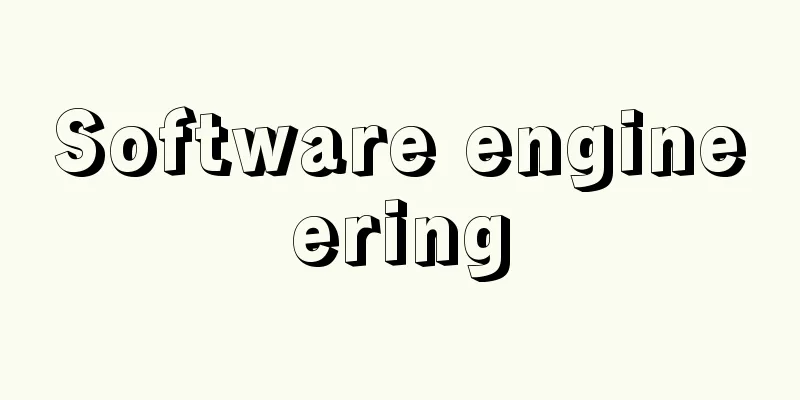Software engineering

|
The term was first used at a conference held in Garmisch-Partenkirchen, West Germany, in 1968, sponsored by the North Atlantic Treaty Organization (NATO), with the aim of improving software production from the traditional handicraft production to industrial production. Software engineering deals with the following fields: (1) techniques, tools, and development support systems for software production, such as design, programming, and testing used at each stage of the software lifecycle, from the elicitation of user requirements to maintenance work; (2) techniques and tools for software management, such as those for effectively managing software production activities throughout the entire software lifecycle; and (3) techniques for software productivity evaluation, such as the organization, standardization, and resource management of software components and documents that are the basis of software production. Today, research, development, and commercialization of software development support systems (CASE systems; Computer-Aided Software Engineering Systems) that unify the human interface and provide interfaces between the tools that should be used, and consistently support software production throughout the entire software lifecycle, have become active, in contrast to the tools previously provided for each lifecycle. Research is also being conducted on technologies such as requirement specification acquisition technology to correctly grasp and clarify user requirements, technology to automatically or semi-automatically synthesize given requirement specifications into a target language, and technology to realize an intelligent programming environment that interactively guides software production work and supports various optimization tasks. Source: Encyclopaedia Britannica Concise Encyclopedia About Encyclopaedia Britannica Concise Encyclopedia Information |
|
ソフトウェア生産を従来の手工業的生産から工業的生産へと改善することを目指し,1968年に北大西洋条約機構 NATOが主催して旧西ドイツのガルミッシュパルテンキルヘンで開催された会議で初めて使用されたことば。ソフトウェア工学で取り扱う分野は,(1) ソフトウェア生産に関する技法やツール,開発支援システム-ユーザー要求の抽出作業から保守作業にいたるライフサイクルの各段階で使用される設計,プログラミング,試験など,(2) ソフトウェア管理に関する技法やツール-ライフサイクル全般にわたり,ソフトウェア生産活動を効果的に管理するためのもの,(3) ソフトウェア生産性評価に関する技術-ソフトウェア生産の基礎となる組織,標準化,ソフトウェア部品やドキュメントなどの資源管理を含む生産性評価に関する技術,である。今日では,これまでライフサイクルごとに提供されていたツールに対し,ヒューマンインターフェースを統一化し,使用すべきツール間のインターフェースをとり,ライフサイクル全体にわたり一貫してソフトウェアの生産作業を支援するソフトウェア開発支援システム(CASEシステム; Computer-Aided Software Engineering System)などの研究開発・製品化が活発になった。また,ユーザーの要求を正しく把握し明確化するための要求仕様獲得技術,与えられた要求仕様から目的言語へ自動・半自動的に合成する技術,対話的にソフトウェア生産作業のガイドを行なったり種々の最適化作業を支援する知的なプログラミング環境を実現する技術などの研究が進められている。
出典 ブリタニカ国際大百科事典 小項目事典ブリタニカ国際大百科事典 小項目事典について 情報 |
<<: Soft tennis - Sofutotenisu (English spelling) soft tennis
Recommend
United Nations Educational, Scientific and Cultural Organization United Nations Educational Scientific and Cultural Organization
…United Nations Educational, Scientific and Cultu...
Schlatter, Adolf
Born: August 16, 1852 in St. Gallen Died: May 19, ...
Anchor Cap Bottle
...Furthermore, because of the disadvantages of c...
Lee Yeol-kun
1882-1946 Chinese soldier and politician. Born on...
Tohimondo - Dialogue between the capital and the countryside
This is the main work of Ishida Baigan, a Shingak...
Sweet clothing - Kan no onzo
…The front and back hems are joined by brocade, s...
Landscape painting - landscape painting (English)
Paintings depicting outdoor landscapes such as na...
Pteroglossus viridis (English spelling) Pteroglossusviridis
…About 37 species are distributed from Mexico to ...
Karakalpaks - Karakalpaks
...Population: 1,214,000 (1989). Ethnic compositi...
Unsaturated polyester resin - Fuhouwa polyester resin
A thermosetting resin made by crosslinking a rela...
Pelecanoides magellani (English spelling) Pelecanoidesmagellani
…[Hiroshi Hasegawa]. … *Some of the terminology t...
Methyl
[ I ] This refers to the CH3- group. It is the si...
Oki Shozo
…An intelligence activist during the Russo-Japane...
Yakumo [town] - Yakumo
A town in Futami District, Hokkaido. It borders Uc...
Chanhu daro (English spelling)
Located near Sakland in the Nawabshah district of ...





![Toyonaka [town] - Toyonaka](/upload/images/67cc5c561c54a.webp)



